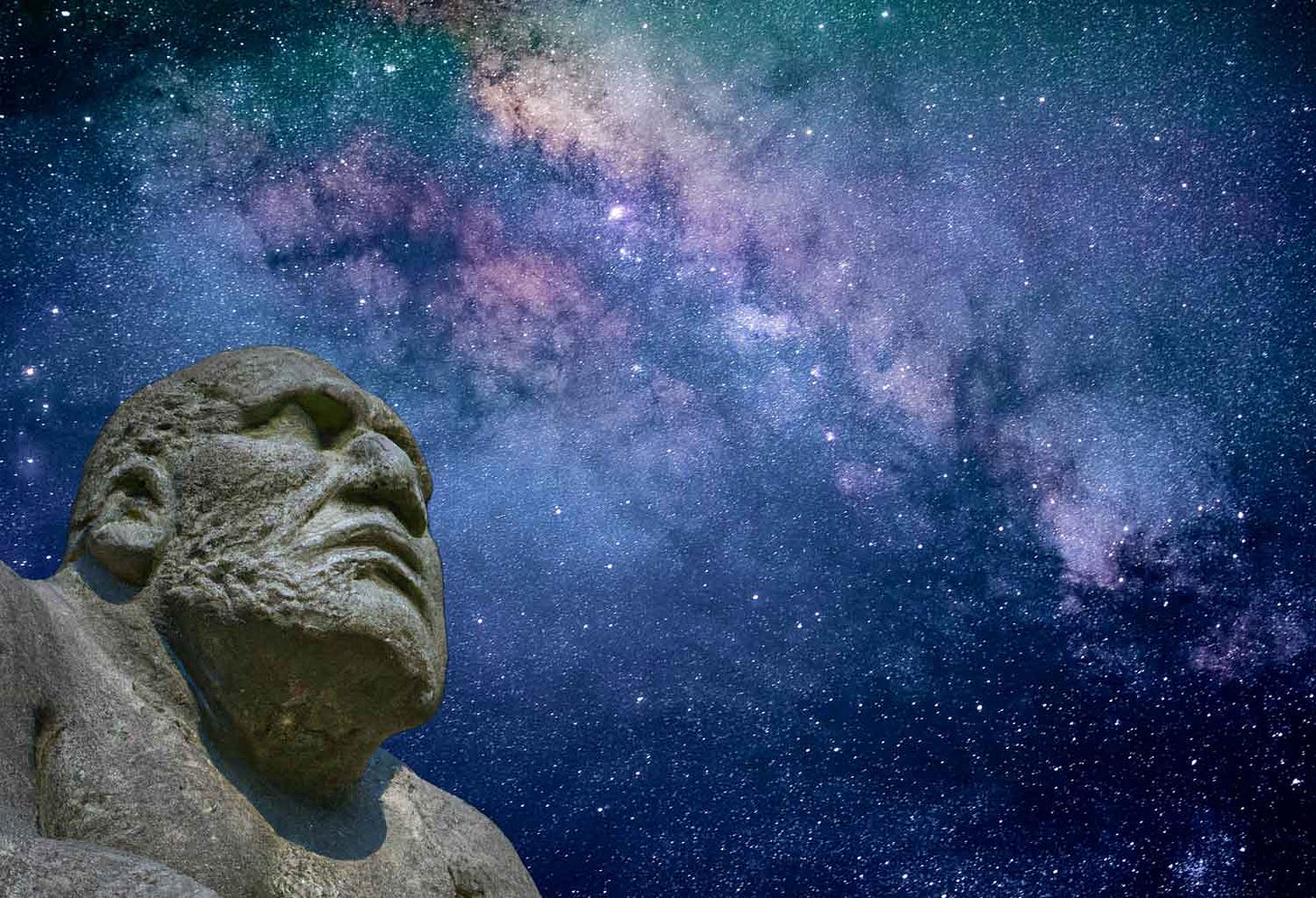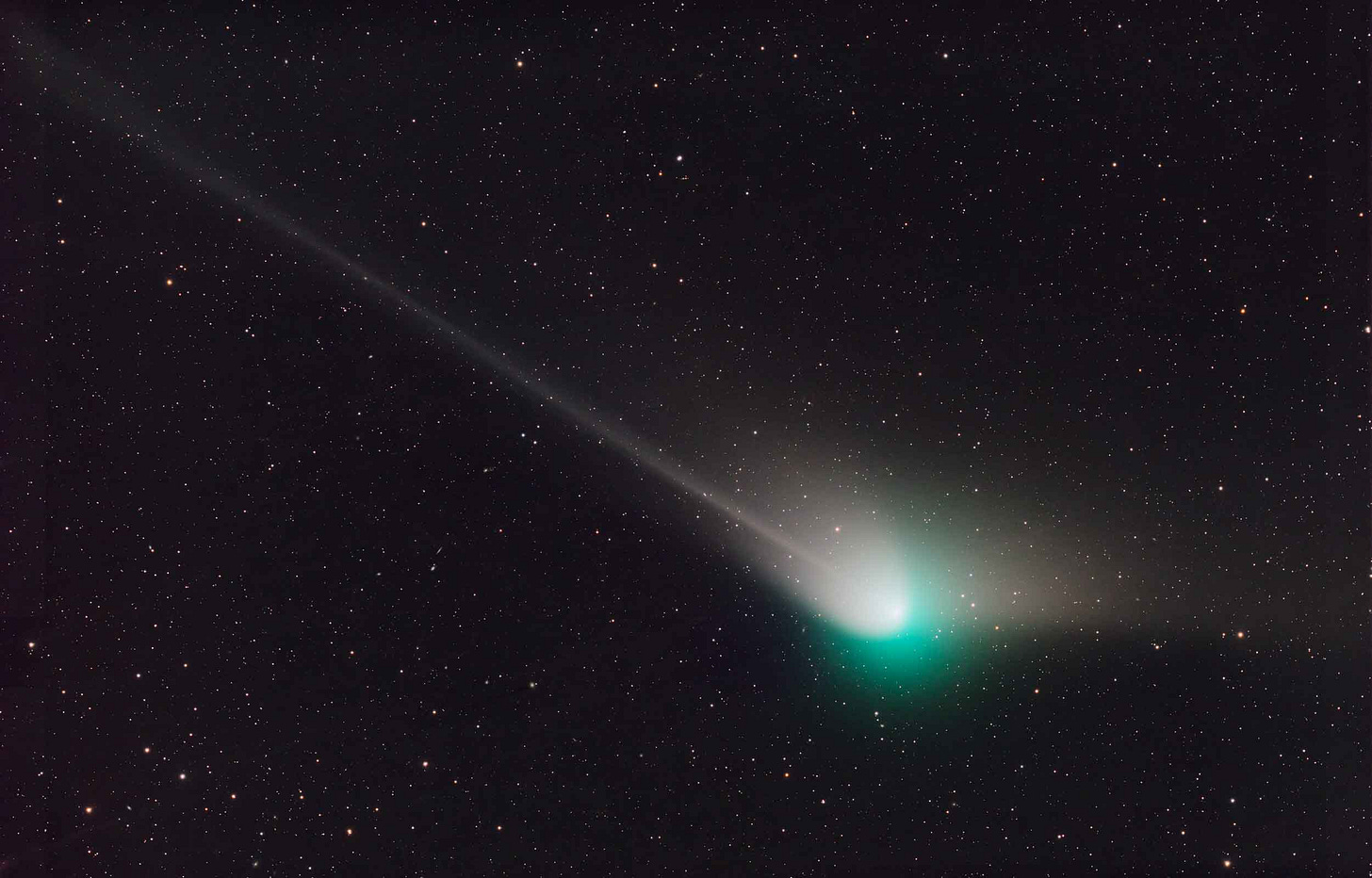When did our ancestors start looking up to the stars?
Changes in the sky have been important to peoples throughout the world. That connection may go back much further than our species.
Last night I went outside to look at the “Green comet”. It's a homely little thing, a faint little cloud in my binoculars.
Last time this comet was nearby was around 50,000 years ago. People are saying that Neandertals were the last to see this comet in Earth's sky. That kind of thing gets my attention. But as I stood outside in the cold and saw the thing, I wondered: Could such ancient people really have looked up and wondered about this tiny moving blob?
Obviously a lot of what we think about the experiences of ancient people must be speculative. We cannot put ourselves into their minds. Still, we know that the skies have mattered to human groups all over the world throughout recorded history. There is something that connects us to the stars, and that connection may have formed long ago within our evolutionary lineage.
“[T]he Quinault kept definite track of both solstices. At several of the villages were ‘seats’ (a stump or stone) where the old men watched both sunrise and sunset. Usually they sighted from the seat to a pole placed in the ground, or to a designated tree.” —from the Quinault people of North America
Today when I think about the relationship of ancient people to the stars, what comes first to mind is the alignments of ancient monuments. Stonehenge points to the solstice sunrise. It's far from alone. Both amateur and professional astronomers have worked to understand possible alignments at many ancient sites—such as recent work at Göblekli Tepe, Turkey, which has some of the earliest megalithic structures in the world.
From time immemorial, groups around the world have recognized the ways that the stars and moon mark significant seasonal events. These are important for people who live by foraging, for whom the seasons may mark times to move to different parts of their geographic range. They are important for people who need to plant crops or to move their herds to fresh pastures.
The ancients had wisdom that we have forgotten. Some of that wisdom lay in their recognition of how changes in the sky may be tied to changes on Earth. Such alignments were central to ancient people and remain relevant today.
Monuments grew from cultures who had raised their understanding of astronomy into a practice of divination. It is a short step from noticing the connection of astronomical and Earth cycles to a belief that signs from the sky may influence events in a person’s life. Such beliefs in many cultures evolved into astrology.
The remnants of ancient divination still exist. It is a rare person now who does not know their zodiacal sign. Magic seems tied up with signs from the stars.
“The comet, too, owes its existence to magic power. When people at sea are driven off course and cast ashore somewhere, they can inform their people that they are still alive by means of a t'úf ni ˚nizón (comet).”—from the people of Yap
Most practical knowledge of astronomy did not leave such durable traces as Stonehenge. But such knowledge was often crucial to sustaining ways of life.
Consider all the peoples who have relied upon the stars for navigation. In their eyes the stars are more than points of light, they are a map leading to every corner of the Earth. The constellations are signs that people connect to stories, and learning those stories teaches their children the ways to derive time and position from the sky. For the peoples of the Pacific, such astronomical signs were part of a broader system of meteorological signs: winds, clouds, wave motions and animals all contributed to their navigational knowledge. The stars, ocean, and Earth were one connected system.
It is the human ability to recognize signs that enables us to see such connections. That ability goes very far back into our evolution. Early hunters' success or failure depended on their ability to read the trackways left by their prey animals. Those signs were as much a part of their landscapes as the stars. The tracks also appeared and disappeared, indications of the passing of animals and time.
Hunting and foraging peoples have recognized the same trackways among the stars. Many have recognized hunters, prey, tracks, and weapons among the constellations. They have recognized stars that are high during the birth seasons or migration seasons of animals.
Ancient African peoples, Neandertals, even populations going back hundreds of thousands of years made marks on objects. Those marks were made by sign-users. The ancient hominins who could make and use signs would have seen signs in the stars. I think we can be sure that the signs in the sky were apparent to some of the earliest members of our genus, Homo.
The deepest signs in the sky are those that connect to human social realities. None have been more significant to cultures around the world than cycles of fertility. And no astronomical observation is more striking than the moon.
“She was menstruating, ‘seeing the moon.’ Besides a word that specifically refers to menstruation, there are a number of common !Kung idioms that have the same meaning, all referring to the moon: ‘going to the moon,’ ‘seeing the moon,’ ‘being with the moon.’ These expressions highlight the importance of the moon in helping women keep track of their cycles, and reflect their sense of being in time with powerful natural forces.”—from the !Kung people
Some peoples have seen the moon as the cause of menstruation, others imagined a deep connection between the moon and the feminine way of being. Nearly all have recognized the coincidence in timing between the lunar cycle and the average menstrual cycle.
Could this have been true in the past? Some anthropologists think that the early use of red mineral pigments was a part of rituals that were symbolic representations of menstruation. Evidence of such pigment use goes back as far in many parts of the world as evidence of markings. Those markings themselves, sometimes etched sequences of lines on pieces of bone, look in many cases like counts of some kind. Some suspect that they were lunar counts.
We do not know whether the ovulatory timing of ancient human relatives was similar to our own. It may have been different: Cycles in chimpanzees and bonobos are variable and longer on average than the average human cycle. Different humans have menstrual cycles that vary in length, so that the apparent synchronicity of the average and the lunar cycle holds true only for some, and only for a limited time.
Yet somehow that lack of consistency has not dimmed people's concepts of a connection between the moon and menstruation. Signs have a power over our minds. Once a connection is seen, or imagined, our thoughts tend to warp to fit it.
Thus amid the powers that shape the Earth, seen and unseen, our ancestors looked up to the unchanging stars. And when the sky changed, they noticed.
“The comet is related to a myth of an ancestor who had taken as wife an alknarintja woman, that is a mythical woman who may not marry. To win her by love charms he made an outline of a woman's form on the ground, threw small spears at it, steeing them afire (the comet's tail) and then threw his spear thrower at it (the comet). When he had by this means won her, he threw away the image of her (the disappearance of the comet).” —from the Aranda people of Australia
People have only known about the comet C/2022 E3 (ZTF) since March 2022, when Bryce Bolin and Frank Masci identified it in data from the Zwicky Transit Facility (ZTF). They worked out the long period of the comet, around 50,000 years, from observations of its speed and movement against the stars behind it. Nobody was waiting for it to arrive. The last time the comet visited our neighborhood was far beyond memories or traditions.
We don't really know if any ancient people could have seen it, of course. The comet might well have been dimmer in the sky than it is now, and now it's not very bright. My binoculars made it apparent even in city skies but not impressive. Astrophotographers suggest that a good telescope may bring the tail into view, but the really good photos are coming from people who use a long exposure.
Still, 50,000 years ago the comet may have been brighter. Its orbit this time takes the comet through the northern sky; last night it was a few degrees from the North Star. It is a conspicuous wanderer for those who know the stars. Of course, that may not have been true last time around. It may have come close to the sun at a time when Earth was at the opposing point in its orbit.
But it it were the same, well. A moving object against the stellar background of the northern sky, far from the wandering planets, is unusual. Someone, somewhere must have noticed.
Notes: The quotes in this post are taken from ethnographic sources that are part of the Human Relations Area Files database at Yale University. I have cited the original sources below. The passage on the !Kung idioms related to the moon comes from Nisa, the Life and Words of a !Kung Woman, by Marjorie Shostak.
Ideas about the relationship between ancient red pigments and menstruation have been expressed by many archaeologists and anthropologists; one good exposition of these ideas is by Christopher Knight in the book Blood Relations: Menstruation and the Origins of Culture.
References
Hambly, W. D. (1934). The Ovimbundu of Angola: Frederick H. Rawson-Field Museum ethnological expedition to West Africa, 1929-30. ; 84 plates in photogravure and 1 map. 21(2). https://ehrafworldcultures.yale.edu/cultures/fp13/documents/003
Knight, C. (1995). Blood Relations: Menstruation and the Origins of Culture. Yale University Press.
Lorenzis, A. D., & Orofino, V. (2014). New Possible Astronomic Alignments at the Megalithic Site of Göbekli Tepe, Turkey. Archaeological Discovery, 03(01), Article 01. https://doi.org/10.4236/ad.2015.31005
Olson, R. L. (Ronald L. (1936). The Quinault Indians. In University of Washington publications in anthropology: Vol. v. 6 (Issue 1, p. 194). The University of Washington. https://ehrafworldcultures-yale-edu.ezproxy.library.wisc.edu/document?id=nr17-001
Shostak, M. (1981). Nisa, the life and words of a !Kung woman. Harvard University Press. https://ehrafworldcultures-yale-edu.ezproxy.library.wisc.edu/document?id=fx10-026
Strehlow, C. (1907). The Aranda and Loritja tribes in central Australia: Part 1, myths, sayings, and folktales of the Aranda tribes. In Veröffentlichungen aus dem Städtischen Völker-Museum: Vol. Vol. 1 (pp. 1–104). Joseph Baer und Co. https://ehrafworldcultures.yale.edu/document?id=oi08-022
Walleser, S. (1913). Religious views and customs of the inhabitants of Yap (German South Seas). Anthropos, Vol. 8, HRAF ms: 1, 69 leaves [original: 607-629, 1044-1068 ]. https://ehrafworldcultures.yale.edu/document?id=or22-021




